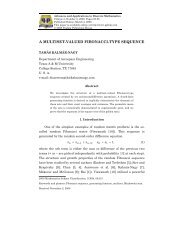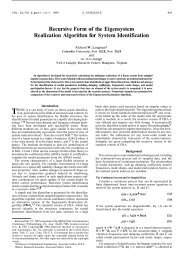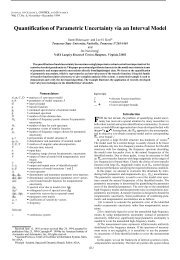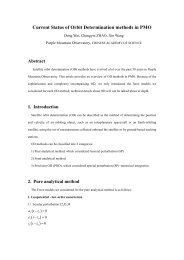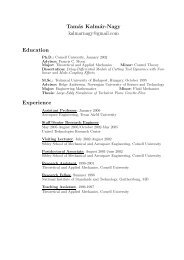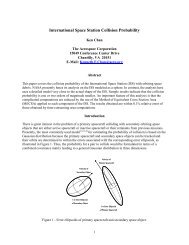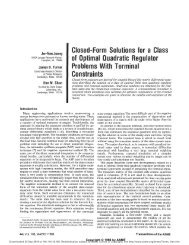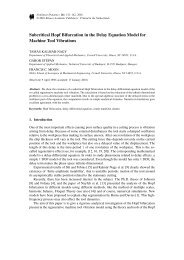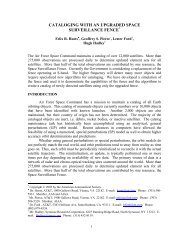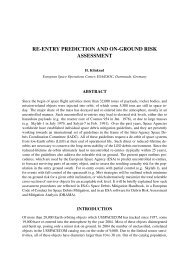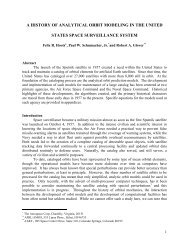Observer/Kalman-Filter Time-Varying System Identification - AIAA
Observer/Kalman-Filter Time-Varying System Identification - AIAA
Observer/Kalman-Filter Time-Varying System Identification - AIAA
Create successful ePaper yourself
Turn your PDF publications into a flip-book with our unique Google optimized e-Paper software.
888 MAJJI, JUANG, AND JUNKINS<br />
The algorithm developed as a consequence is called the time-varying<br />
observer/<strong>Kalman</strong>-filter system identification (TOKID). In addition,<br />
the tools systematically presented in this paper give an estimate<br />
on the minimum number of experiments needed to perform<br />
identification and/or recovery of all the Markov parameters of<br />
interest until that time instant. Thus, the central result of the current<br />
paper is to make the number of repeated experiments independent of<br />
the desired resolution of the model. Furthermore, because the<br />
frequency response functions for time-varying systems are not well<br />
known, the method outlined seems to be one of the first practical<br />
ways to obtain the generalized Markov parameters, bringing the<br />
time-varying identification methods to the table of the practicing<br />
engineer.<br />
Novel models relating I/O data are developed in this paper and are<br />
found to be elegant extensions of the autoregressive exogenous input<br />
(ARX) models, well known in the analysis of time-invariant models<br />
(cf., Juang et al. [11]). The ARX model is a linear difference equation<br />
that relates the input to the output. This generalization of the classical<br />
ARX model to the time-varying case admits analogous recursive<br />
relations with the system Markov parameters, as was developed in<br />
the time-invariant case. This analogy is shown to go even further and<br />
enable us to realize a deadbeat observer gain sequence for timevarying<br />
systems. The generalization of this deadbeat definition is<br />
rather unique and general for the time-varying systems, as it is shown<br />
that not all the closed-loop time-varying eigenvalues need to be zero<br />
for the time-varying observer gain sequence to be called deadbeat.<br />
Furthermore, it is demonstrated that the time-varying observer<br />
sequence (deadbeat or otherwise) computed from the ARX model is<br />
realized in a compatible coordinate system with the identified plant<br />
model sequence. Relations with the time-varying <strong>Kalman</strong> filter are<br />
made, comparing with the time-varying observer gains realized from<br />
the TOKID procedure presented in the paper.<br />
II. Basic Formulation<br />
We start by revisiting the relations between the I/O sets of vectors<br />
via the system Markov parameters, as developed in the theory<br />
concerning the TVERA (refer to companion paper [9], based on [10],<br />
and the references therein). The fundamental difference equations<br />
governing the evolution of a linear system in discrete time are given<br />
by<br />
together with the measurement equations:<br />
x k 1 A k x k B k u k (1)<br />
y k C k x k D k u k (2)<br />
with the state, output, and input dimensions x k 2 R n , y k 2 R m , and<br />
u k 2 R r , and the system matrices to be of compatible dimensions<br />
8 k 2 Z, an index set. The solution of the state evolution (the linear<br />
time-varying discrete-time difference equation solution) is given by<br />
X k 1<br />
x k k; k 0 x 0 k; i 1 B i u i (3)<br />
i k 0<br />
8 k k 0 1, where the state transition matrix :; : is defined as<br />
8<br />
< A k 1 ;A k 2 ; ... ;A k0<br />
8 k>k 0<br />
k; k 0 I k k<br />
:<br />
0 (4)<br />
undefined 8 k





